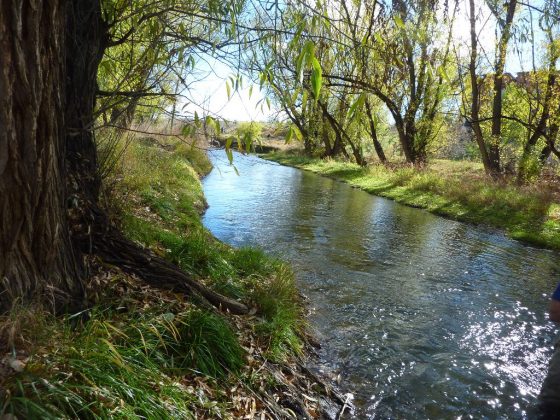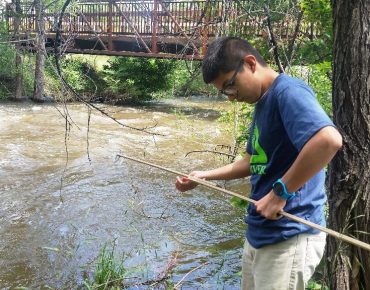A Watershed Plan Is Born
Lower Bear Creek, an 8.2-mile stretch of creek that flows through the City of Lakewood in Jefferson County, Colorado, the City and County of Denver, and the City of Sheridan in Arapahoe County, is a place where residents can recreate, host family gatherings, and enjoy the outdoors. Land uses around the Creek include low- and high-density residential areas, open spaces, and business developments. The Creek begins as a trickle on top of Mount Evans, Denver’s nearest 14,000-foot peak, then travels through forests, unaffected by urban pollution until it reaches the suburbs west of Denver. There the water quality of Bear Creek changes dramatically.

In 2010, the Lower Bear Creek, between Kipling Parkway and the confluence with the South Platte River, was listed as impaired by the Colorado Department of Public Health and Environment (CDPHE) because of elevated levels of the bacterium Escherichia coli (E. coli). E. coli is a bacterium that aids digestion in warm-blooded animals. Its presence in environmental waters indicates fecal contamination. Pathogenic bacteria, viruses, and parasites can also be present where there is fecal contamination. Recreating in urban waters can pose public health risks if polluted water is ingested or enters the body through open cuts or wounds.
Groundwork Denver’s Green Team had been working, since 2010, on invasive species removal and habitat restoration along the Bear Creek. As a result of the Green Team’s work on the Lower Bear Creek, Groundwork Denver became interested in doing more to improve the creek. They met with CDPHE, which encouraged them to apply for a non-point source pollution grant for watershed planning. Developing a non-point source watershed plan was a necessary next step in the process of addressing the elevated levels of E. coli in Lower Bear Creek.

Partnerships, Science, and Education
In 2012 Groundwork Denver received funding from CDPHE through the Environmental Protection Agency’s (EPA) 319 Non-point Source funds. With EPA’s funding, Groundwork Denver has successfully created a non-point source watershed plan for the Lower Bear Creek. To make this project possible, a strategic effort was made to form the right partnerships. Because non-point source contamination is not the issue of one entity per se, it made sense to bring many partners to the table. Denver convened Denver Parks and Recreation, Denver Environmental Health, the City of Sheridan, Lakewood Parks and Open Space, the National Parks Service Rivers, Trails, and Conservation Assistance program, the Cutthroat Chapter of Trout Unlimited, and residents of Lakewood, Denver, and Sheridan, Colorado. Each partner participated in the Lower Bear Creek project either as part of the steering committee or a subcommittee.
Using EPA’s “Nine Elements for a Watershed Plan” as their guide, project stakeholders helped determine what a watershed plan for Lower Bear Creek should look like. Completing the watershed plan required many steps, including identifying causes of impairment and pollutants, conducting community engagement, and sampling water quality. In addition to E. coli sampling, a River Watch team was instituted during the planning process. River Watch is a state-wide organization that supports groups in analysis of metals, nutrients and macroinvertebrates for water bodies. River Watch sampling of Lower Bear Creek began in winter 2013.
Community Engagement
Project partners connected with community members through various methods over a two-year period. Door-to-door canvassing and volunteer events along the Lower Bear Creek ensured area residents were informed about the watershed planning process, and over 100 area residents participated in cleanup and habitat restoration activities along the Creek. Events offered residents and volunteers the opportunity to learn about urban water quality, wildlife habitat preservation, and actions individuals can take to protect urban waters.
Success
The watershed plan, completed in October 2014, was a major success for Groundwork Denver and its partners. The primary goals of the plan include ongoing water quality sampling, partnership building, and community education and stewardship. Achieving success required bringing the right combination of experts to the table. Natural areas, environmental health, and public health experts share the Groundwork passion for clean air and water.

Next Steps
The next step for the Bear Creek project is to accumulate several years of data based on the water quality monitoring plan described in the watershed plan. This data will be used to implement structural best management practices (BMPs) along the Creek. In the summer of 2015, Groundwork Denver recruited a team of six dedicated high school students from Denver’s Sheridan High School to support its ongoing water quality sampling efforts. This “Blue Team” spent two months in the field collecting samples and field parameters. Students also learned about potential career options from partners at the U.S. EPA, the Bear Creek Watershed Association, U.S. Fish and Wildlife Service, South Suburban Parks and Recreation, Earth Force, and the Metro State University Biology Department.
